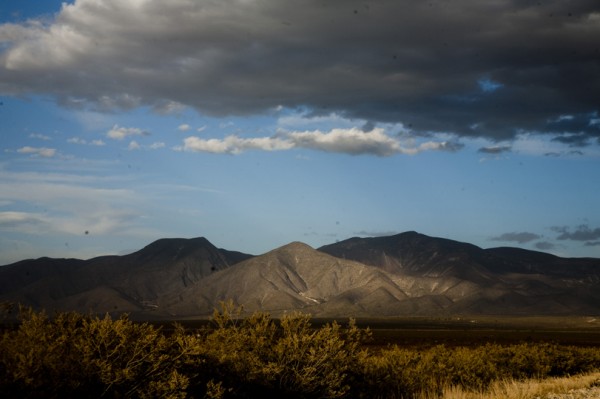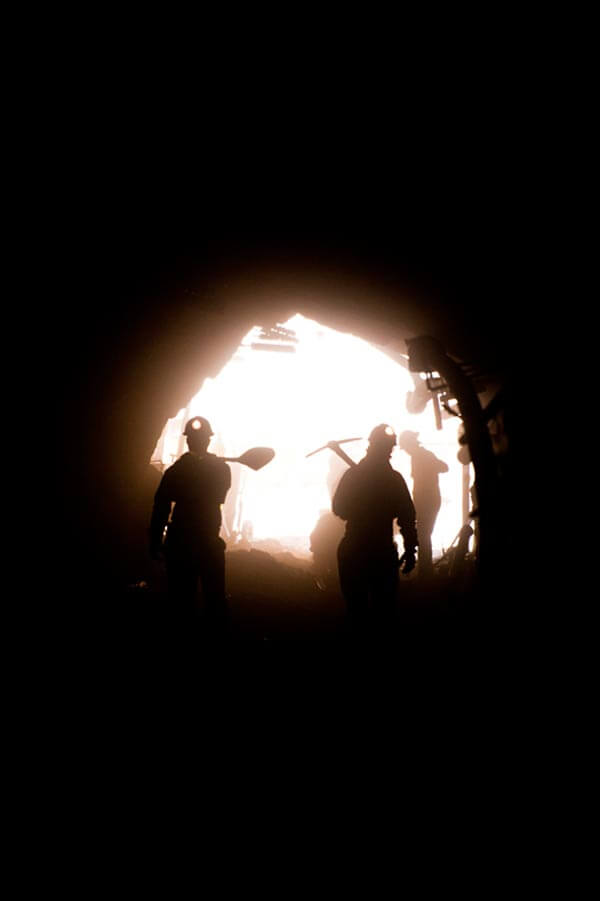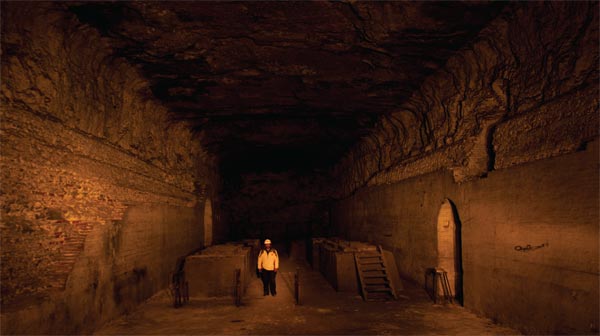A Canadian mining company prepares to dig up Mexico’s Eden
Vancouver’s First Majestic Silver plans to mine for silver in the heart of Mexico’s peyote country. For the Huichol people, the project is an environmental risk—and a spiritual crisis
Photographs by José Luis Aranda

The Wirikuta mountain range in the Chihuahua desert in central Mexico. Photo by José Luis Aranda.
Under a heavy afternoon sun, the desert landscape in central Mexico lays long into the horizon, interrupted only by railroad tracks, roadrunners racing beside cars, and every once in a while, a cluster of houses and shops. But towards what some consider the sacred heart of the desert, new features begin to emerge: new age hippies and fellow travellers compete for rides on the side of the road, and in the distance, a dramatic mountain range rises from the plane.
Stretching from Arizona to San Luis Potosí, the Chihuahuan desert wraps around two of Mexico’s largest mountain ranges, laying claim to over 450,000 square kilometers of territory. While at first glance the topography might appear dry and barren, it is in fact home to a fifth of the world’s species of cacti, as well as a host of birds and other creatures.
But there’s one plant in particular that’s an essential part of the region’s draw: peyote. A small, circular cactus, divided into sections that look like a light green cross section of a mandarin orange, it pushes its way out from under the hard dry earth, sometimes into the direct sun, other times under the sparing shade of gobernadora plants.
In the southern reaches of the Chihuahuan desert is an area known as Wirikuta, a sacred site for the Huichol people. Every year, hundreds of Huichol people, whose name for themselves in their own language is Wixáritari, leave their communities in Jalisco, Nayarit and other parts of Mexico and begin a pilgrimage to Wirikuta.
“For us it’s like a temple,” says Marciano de la Cruz Lopez of Wirikuta. He’s one of the few Huichols making a home in the small, mining-cum-tourist town of Real de Catorce.
Wirikuta’s 140,000 hectare site was recognized by the state government as a Natural Protected Area and Sacred Site in 2000. It also includes a 146-kilometre path through the landscape named the Historic Route of the Wixárika People. In 1998, UNESCO declared Wirikuta as one of the world’s 14 natural sacred sites in need of protection.
“It’s a sacred site where we can leave our offerings when we do ceremonies there in the mountains, or when the pilgrims come,” says de la Cruz. “It means everything to us, as Huichol people.”

Alberto Hernandez Gonzales, a Huichol guardian of Wirikuta. Photo by José Luis Aranda.
The Huichols are among the few indigenous groups in Mexico who were never successfully converted to Catholicism by Spanish colonizers, and their fidelity to their traditions is celebrated throughout the country. “I congratulate all of you, the traditional governors, the Wixárica union from the ceremonial centres of Jalisco, Durango and Nayarit, to all of you, for defending these holy places, these marvellous places,” President Felipe Calderón said in a 2008 speech, while dressed in a traditional Huichol pullover and feathered hat.
Huichols believe that Cerro del Quemado, the stunning mountain range that rises from Wirikuta, is the birthplace of the sun and of all life. At the mountain’s summit is a structure where the Huichols leave offerings of thanks as part of their ceremonies: feathers, arrows, water from sacred springs, and other precious objects.
But this historic spiritual site is now at risk, its ancient landscape threatened by modern industry. And for the Huichol people, the stakes couldn’t be higher: the prospect of mining for silver under their holy mountain not only endangers the safety of their water supply; it represents a spiritual affront. Imagine drilling for oil under the Vatican, or bulldozing Eden to make room for a golf course.

Miners working at the former La Luz mine owned by First Majestic Silver. Photo by José Luis Aranda.
First Majestic Silver, a Vancouver-based mining company, holds a series of concessions that overlap with Wirikuta, and the company’s plans to develop the mine have already been controversial locally and around the world.
First Majestic already owns three producing silver mines, in Durango, Coahuila, and Jalisco, and is preparing to bring a fourth mine online. The project at Real de Catorce is the earliest-stage project the company owns, and they have yet to begin the permit process. If First Majestic receives all the permits needed—which have not yet been acquired—they expect to start producing silver at the property in 2014. Technical studies carried out by the previous owners of the concessions at Real de Catorce indicate that mining the silver laden tailings left over from historic mines combined with opening up new mine shafts in Real de Catorce could net 33 million ounces of silver, as well as substantial quantities of lead and zinc. The company says they’ll employ at least 600 locals by the time production begins, and the mine could operate for as many as 15 years.
The common thread that unites the company and many of those opposed to the project is something that’s sorely lacking in the region: water.
“There’s a limited amount of water here,” says Humberto Fernandez, owner of the Hotel Real, perhaps the most prestigious accommodation in Real de Catorce. “The aquifer here is disappearing,” he says. We met Fernandez and his wife Cornelia over lunch in the restaurant of the hotel that he’s owned and operated for almost 35 years. From the right angle, with his grey hair pulled back in a ponytail, wearing a green corduroy shirt and a peyote charm on his necklace, Fernandez bears a slight resemblance to Fidel Castro, and he talks a mean streak, too.
“Water is the main cause for concern that we’ve noticed among the local population,” he says, sitting straight up in his chair and talking over a steaming plate of pasta. “There’s been weeks without any water in the village.”
The local aquifer providing what scarce water there is in the region, is classified as “over-exploited” by the National Water Commission. The water problem isn’t new: when the local mines were operating at full tilt in the 19th century, there wasn’t enough water to run a mill in Real de Catorce.
“The water supply is still in the planning phase,” says Todd Anthony, head of First Majestic’s investor relations department, from his office in Vancouver. “but its not going to disrupt any supply to the local community there. We’ve got other plans in mind,” he says. He refused to elaborate on what those possible alternatives might be, however.

Interior of the former Santa Ana mine. Photo by José Luis Aranda.
The anti-mining fight in Wirikuta and Real de Catorce is far from the first flashpoint of resistance against Canadian mining companies in the Mexican state of San Luis Potosí. In fact, it is in many ways mirrors a struggle that has been going on in the equally picturesque village of San Pedro. Also a colonial mining town, the Cerro de San Pedro was of such importance in the region that it is featured to this day in the centre of the state’s official emblem.
Except the Cerro de San Pedro hardly exists anymore. Over the past four years, the hill has been blown to pieces and trucked to a cyanide treatment plant. Instead of rising like a tiny, stand alone colonial mecca half an hour by car from the city of San Luis Potosí, San Pedro today is surrounded by growling dump trucks and mountains of cyanide treated waste rock, by-products of a large scale, open pit silver and gold mine operated by Vancouver-based New Gold.
The abundance of new mining projects popping up across Mexico have generated enough problems throughout the country to prompt the creation of a Special Commission for Mining Conflicts in the national congress. Anti-mining activists and industry groups alike trace surge in investment in the mining sector back to the North America Free Trade Agreement.
“To facilitate what’s happening now, the pillaging of our country and the arrival to our country of a large quantity of companies— especially mining companies—it was necessary to have a working free trade agreement,” says Mario Martínez, a spry septuagenarian anti-mining activist from San Luis Potosí. Among the key changes in legislation NAFTA wrought were adjustments to Article 27 of Mexico’s constitution, which defines the legal framework for the ownership of land and the use of natural resources.
But Enrique Flores, an engineer working with First Majestic Silver, says things have changed for the better in the world of mining. I caught up with him on the company-owned hacienda in the village of La Luz, which lies just a few kilometres outside of Real de Catorce. He was animated and talkative, having just returned from a workshop at the Canadian Embassy in Mexico City on Corporate Social Responsibility.
“Mining investment is made for profit, but at the same time it provides work for people, and raises the standard of living here,” says Flores, who took the time to show me images of the proposed mining project, pointing out on a map where the company is going to work, and how. “For example, in the case of Canadian mining companies, the government of Canada follows very closely what their companies are doing in other countries,” he says.
But though corporate social responsibility and Canadian government oversight might sound like progress, there are no binding international standards through which Canadian mining companies can be held accountable for their actions around the world, says Jennifer Moore from Canadian mining watchdog group MiningWatch Canada.
This fact didn’t seem to ruffle Flores, who took me on a tour through the historic Santa Ana mine. A few dozen locals are already working for First Majestic to transform the abandoned mine into a museum—part of the company’s promise of long-term jobs to the community. Deep inside the hills, the cool, dark mineshaft widened in places and exposed large galleries that once featured the most upto-date technology in the country. In other places, traces of more primitive mining were visible, sometimes overlaid with red spray paint indicating that there’s still silver in the walls after all these years.

Humberto Fernandez, owner of the Hotel Real and opponent of First Majestic Silver's mining plans. Photo by José Luis Aranda.
Just how sacred is Wirikuta? “Wixárika culture is about living for ceremony, because that is the form of life, there is no other form of living,” says Javier Ignacio Martínez Sánchez, an anthropologist originally from Chiapas who has lived in the heart of Wirikuta, for more than a decade. “It breaks your heart to see how they dance, to see the corn that they come and leave here, or the blood of the deer, how much it took to go hunt it, how much it all takes,” he says.
Martínez cuts an eccentric figure: he pays the rent on the tiny adobe igloo in which he lives by giving massages, and his only possessions are a bed surrounded by musical instruments, a few neat stacks of books, an empty plastic cooler, and a smattering of feathers and other ceremonial items.
With a masters’ thesis on the use of peyote under his belt, Martínez has worked hard to integrate himself into desert society, and to help build links between the Huichol pilgrims and the communal owners of the land they must travel. He’s the first to point out that Huichols’ annual trek through the desert also carries great significance for others living in the area.“The [landowners] here already made the link between the presence of the Huichols and the arrival of the rains,” says Martínez from his perch on the edge of his bed. “They say that when the pilgrims arrive on foot, it meant that there would be a good harvest.”
The use of peyote at the end of the pilgrimage is of supreme importance to the Huichols, who are considered the guardians of the spiritual tradition of peyote use. Only after weeks of fasting and celibacy and a long walk through the desert armed with the blood of a freshly sacrificed deer, can the mythic cactus—more often referred to as “medicine,” or hikuri in the Wixárika language—be consumed.
The fact that there’s mineral wealth under such a special site didn’t come as a surprise to Marciano de la Cruz’s wife, Yolanda. “The shamans always said that where there are sacred things, there are mines,” she interjected, looking up for just a moment from the intricate combination of thread and beads between her fingers.
“Our medicine is like a teacher, because it teaches us many things,” says de la Cruz. While we talked, Yolanda continued with her beading, while his children shifted their attention between a plastic bowling set on the floor and a cartoon on the family’s small television set.
De la Cruz is also among those concerned about impacts on the water from the proposed mining operation, but for a more particular reason. “Here there’s not much water, they say it takes lots of water to wash the rocks in mining, for silver, after they do that the water can run underground and it can contaminate our medicine,” he says. “And then we’re going to eat the medicine, and it could affect us.”
The Huichol people are, of course, not the only ones to take advantage of the powers of peyote. The cactus, which contains the psychedelic alkaloid mescaline, is used by Indigenous peoples throughout the northern part of the hemisphere. The Native American Church is a registered organization in the US whose members have the right to use and transport peyote.
But its use by non-Indigenous people throughout the 1960s and 70s might just be that which has brought the most attention to the sacred plant. Peyote was a cornerstone of the beat generation’s hallucinogenic trips, inspiring part of Allen Ginsberg’s epic Howl, and figuring into the writings of other such as William S. Burroughs and Ken Kesey. Rock stars got in on the game too: Jim Morrison, legendary front man for the popular American rock band The Doors, was known to experiment with peyote.
The cultural legacy of psychedelic art influenced by mescaline still resonates today. Tourists from around the world, inspired by the far-out message of the beat writers, flock to the desert, and to Wirikuta, to sample the effects of the button-like cactus on their own consciousness.
Sol Rak is one such visitor to the region, who has made the trek from his home in Chiapas more than 10 times in order to participate in ceremonies in the mountains that separate Real de Catorce from the desert below. “I love going to Quemado,” says Rak, who travels with fire sticks and a Temascal drum.
But mass cutting and overuse of peyote by outsiders has led to its near extinction in some regions, and it’s forced the Huichol people to set up a system to oversee who enters and leaves Wirikuta.
One of these Huichol look outs is a simple cement house on the edge of Las Margaritas, where Alberto Hernandez Gonzales lives with his wife and two teenage sons. “My job is to be here watching to make sure there is no pillaging [of peyote],” says Hernandez, whose Huichol name is Mukieri Kuayumania, which means “from the feather of an unknown bird.”
The first time we tried to meet with Hernandez he was dead tired, having done a 24 kilometer patrol of the area on foot. He was appointed to the post for a three-year term by a community assembly in his home village. And though he says he’s managed to stop some peyote thieves from entering Wirikuta, he quickly adds that he and guardians like him are severely lacking in resources. There’s only three of them working when there should be six, he says, and he doesn’t even have a mule upon whose back he could more easily safeguard the area.
Under a strong wind that moved through the plastic notches hanging from Hernandez’s traditional hat, he recounted the five points of the Huichol universe from a notebook containing carefully written notes.
“We really need to take care of these sites, they are the historical patrimony of our ancestors,” says Hernandez, referring to the threat posed by First Majestic Silver. “The Wixárika communities don’t want these places to be destroyed.”
Flores, speaking on behalf of the mining company, says First Majestic will do its best to leave the Huichol’s sacred sites alone. “The company is, what do you call it, promising to respect the ceremonial centres of the Huichols,” he says. “In fact in a meeting with the Huichol gentlemen we’re going to propose that they take over this part, and we won’t touch it,” says Flores, pointing his finger onto a section of the map that includes part of Wirikuta.
But company’s claims that they won’t touch Cerro Quemado and will work underground instead of open pit mining don’t comfort Hernandez, who likens Wirikuta to his own body.
“The mountain, in any case, is ourselves,” he says. “Right now we’re alive because we are complete. If someone comes along and splits my stomach open and rips out my insides, I’m no longer alive.”